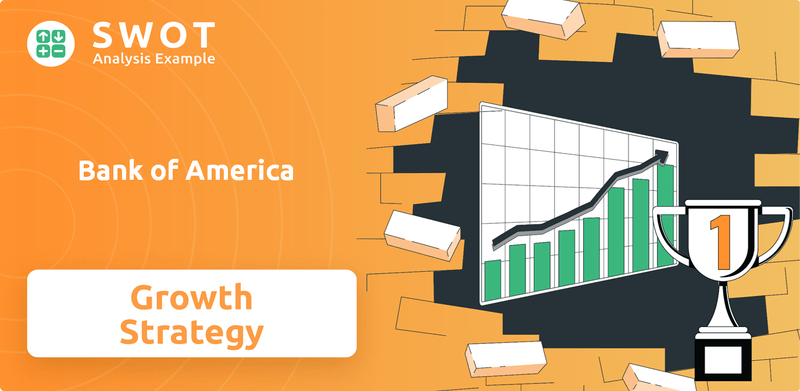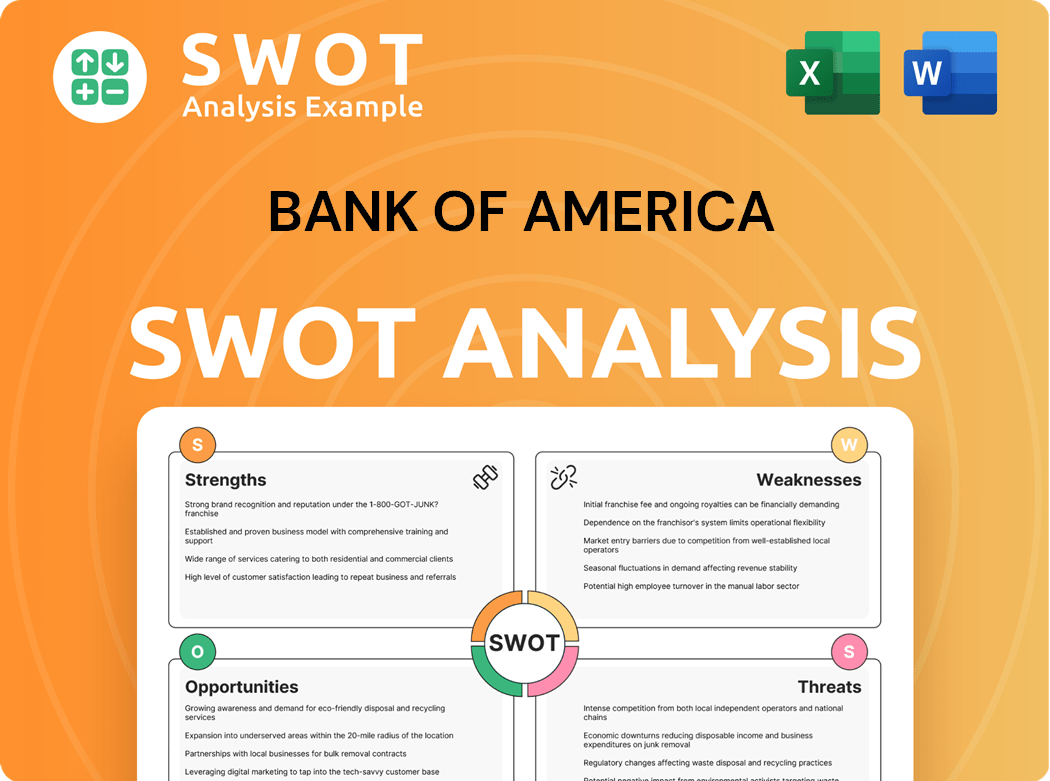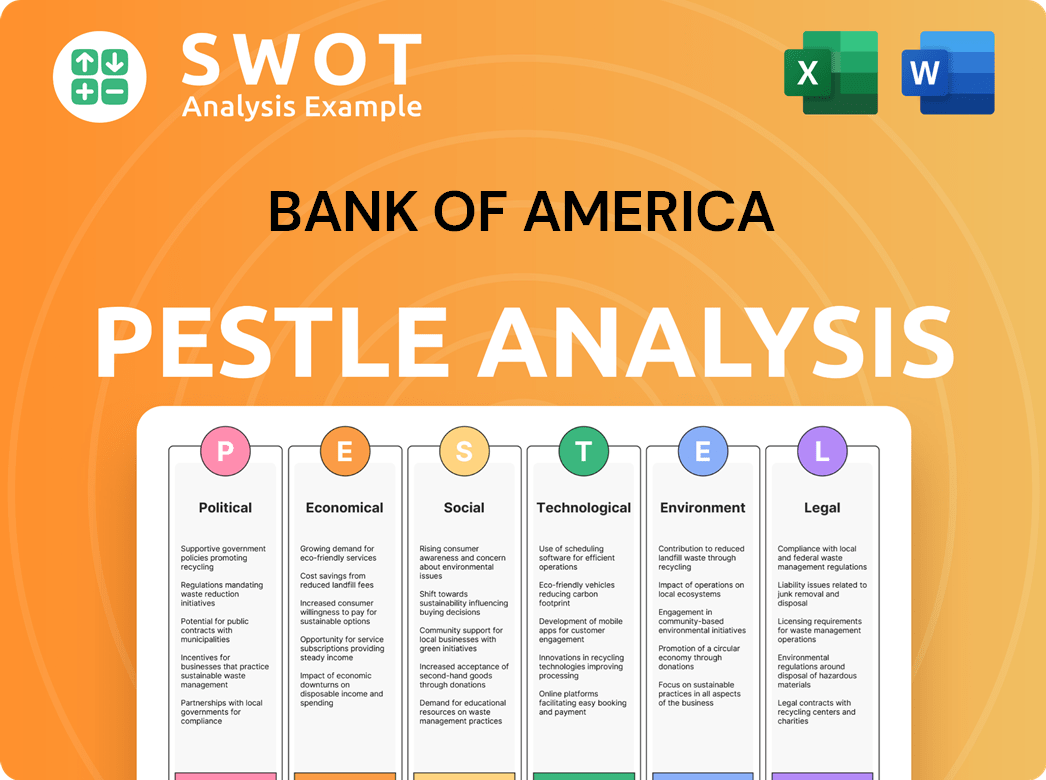Bank of America Bundle
Can Bank of America Sustain Its Growth Trajectory?
Bank of America, a financial titan with roots stretching back to 1904, stands as a cornerstone of the global economy. From its humble beginnings serving working-class citizens, it has evolved into a behemoth with trillions in assets. This exploration dives into the Bank of America SWOT Analysis to understand its strategic initiatives and future prospects.

Understanding the Bank of America's growth strategy is crucial for investors and analysts alike. This comprehensive analysis will examine the company's strategic initiatives for expansion, its embrace of innovation and technology, and its financial outlook, including potential risks and opportunities. We'll delve into the BofA business model, assessing its market position and long-term growth potential to provide actionable insights for informed decision-making regarding Bank of America's future.
How Is Bank of America Expanding Its Reach?
As part of its Bank of America Growth Strategy, the company is actively pursuing various initiatives to broaden its business reach. These efforts focus on attracting new customers, diversifying revenue streams, and maintaining a competitive edge in the constantly evolving financial sector. The bank's expansion is primarily driven by organic growth across its eight lines of business, demonstrating a commitment to sustainable development and market penetration.
In 2024, Bank of America experienced continued growth, adding 3.7 million new retail banking clients. This expansion highlights the bank's ability to attract and retain customers in a competitive market. Furthermore, the bank added approximately 24,000 net new relationships in its wealth management businesses, Merrill and The Private Bank, in 2024, showcasing its strength in serving high-net-worth individuals and families.
A notable trend is the increasing number of wealth management clients who also open banking accounts, with over 60% having a banking relationship with Bank of America. This integration of services underscores the bank's strategy to provide comprehensive financial solutions and build stronger customer relationships. This approach supports the Bank of America Future Prospects by fostering customer loyalty and increasing the potential for cross-selling opportunities.
Bank of America is heavily investing in technology and digitalization to enhance its offerings. This includes improvements in digital tools and platforms to meet the changing needs of its clients. The bank's focus on digital solutions is a key component of its strategy to improve customer experience and operational efficiency. This digital focus has also translated into record digital sales, accounting for 55% of total consumer sales in 2024.
The bank is seeing a significant rise in client preference for digital tools. As of Q1 2024, approximately 57.2 million clients were using digital services. Digital interactions by Bank of America clients grew 12% in 2024, reaching a record 26 billion interactions. This shift towards digital platforms is a key factor in driving efficiency and improving customer engagement.
The use of Zelle has surged among Bank of America clients. In 2024, a record 23.7 million Bank of America clients used Zelle. They sent and received 1.6 billion transactions valued at $470 billion in 2024, representing a 25% and 26% year-over-year increase, respectively. Zelle transactions were nearly triple the number of checks written in Q4 2024, indicating a strong preference for digital payment methods.
For its Global Banking clients, payment approvals through the CashPro App reached a digital record of $1 trillion in 2024. This highlights the bank's success in providing efficient and secure digital payment solutions for its corporate clients. This also shows how the bank is adapting to meet the demands of its global banking clients and improve their operational efficiency.
Bank of America's commitment to digital innovation has been recognized with numerous accolades. The bank received No. 1 rankings in the 2024 Digital Transformation Benchmarking Study by Crisil Coalition Greenwich. Furthermore, it was named Best Bank for Innovation and Ease of Doing Business in the 2025 Crisil Coalition Greenwich Awards. These awards underscore the bank's leadership in digital transformation and its dedication to providing superior services.
- These initiatives are essential for the Bank of America Company Analysis.
- The bank's focus on digital transformation is a key driver of its Bank of America Financial Performance.
- The bank's strategic initiatives are designed to enhance its Bank of America Market Position.
- For more insights into the bank's history, consider reading the Brief History of Bank of America.
Bank of America SWOT Analysis
- Complete SWOT Breakdown
- Fully Customizable
- Editable in Excel & Word
- Professional Formatting
- Investor-Ready Format

How Does Bank of America Invest in Innovation?
The financial landscape is rapidly evolving, and Bank of America is actively leveraging innovation and technology to stay ahead. This strategic focus is essential for maintaining a strong market position and driving future growth. The bank's approach includes significant investments in artificial intelligence (AI) and digital transformation to enhance customer experiences and operational efficiency.
Bank of America's commitment to technological advancement is evident in its substantial financial allocations. The bank's strategic initiatives are designed to improve customer service, streamline internal processes, and create new revenue streams. This commitment is a key element of its overall growth strategy, ensuring it remains competitive in the financial services industry.
Bank of America is investing heavily in technology to drive sustained growth, focusing on digital transformation and cutting-edge technologies. In 2025, the bank is allocating $4 billion to AI and new technology initiatives, representing nearly a third of its overall tech budget. This investment underscores the bank's commitment to revolutionizing its operations and customer experiences. This strategy is a core component of its Marketing Strategy of Bank of America.
Erica, the AI-powered virtual assistant launched in 2018, is a cornerstone of Bank of America's AI strategy. Erica handles approximately 2.4 billion interactions annually with a 98% containment rate. It serves 20 million active users.
The bank plans to expand Erica's capabilities, including integrating generative AI by 2025. This enhancement aims to boost productivity and improve compliance. This strategic move aligns with the bank's focus on leveraging advanced technologies to enhance customer service and operational efficiency.
Erica for Employees is used by over 90% of Bank of America's 213,000 employees. It has significantly reduced IT support calls by more than 50% since 2020. This internal tool demonstrates the bank's commitment to improving employee productivity and streamlining internal processes.
Other AI platforms, such as Ask Merrill and Ask Private Banking, processed 23 million interactions in 2024. These platforms assist wealth advisors in delivering personalized service. This supports the bank's strategy of using AI to enhance customer relationships and provide tailored financial advice.
Bank of America's pragmatic AI strategy focuses on small language models (SLMs) tailored for specific tasks. These tasks include compliance alerts, customer service scripts, and fraud detection. This approach helps reduce costs while maximizing ROI.
AI tools have boosted developer productivity by 20% and saved tens of thousands of hours annually. This is achieved by automating research and analysis for client meetings. Customer service representatives utilize AI to personalize interactions and reduce call handling times.
Bank of America holds nearly 7,400 patents and pending applications, with over 1,200 focused on AI and machine learning. This demonstrates its leadership in innovation. The bank also has an AI oversight council to manage safety and governance, ensuring responsible and ethical use of AI technologies.
- The bank is committed to sustainable finance, with plans to commit $1.5 trillion by 2030.
- These initiatives are designed to enhance the bank's competitive advantage.
- They also drive long-term growth potential.
- The bank's strategic initiatives are designed to improve customer service.
Bank of America PESTLE Analysis
- Covers All 6 PESTLE Categories
- No Research Needed – Save Hours of Work
- Built by Experts, Trusted by Consultants
- Instant Download, Ready to Use
- 100% Editable, Fully Customizable

What Is Bank of America’s Growth Forecast?
Bank of America concluded 2024 with robust financial outcomes, illustrating a strong financial foundation. The company's performance reflects strategic initiatives aimed at sustained expansion and market leadership. This financial health sets a positive tone for future growth and investment opportunities, as detailed in this comprehensive analysis of the Bank of America Growth Strategy.
The bank's revenue streams are well-diversified, with a significant portion derived from net interest income and fees. This balanced approach helps mitigate risks and ensures stability in varying economic conditions. For a deeper understanding of how the bank generates revenue, explore the Revenue Streams & Business Model of Bank of America.
Looking ahead, Bank of America anticipates continued growth in 2025. The company's leadership projects record net interest income, supported by stabilized deposits and growing loan balances. This positive outlook is further reinforced by the anticipation of economic growth and strategic initiatives designed to capitalize on emerging opportunities, making Bank of America a key player in the financial sector.
Bank of America reported over $100 billion in revenue and $27.1 billion in net income for 2024, with earnings per diluted share at $3.21. The bank's share price increased by 30.5% year-over-year, outperforming the S&P 500. The company's financial performance highlights its strong market position and effective strategies.
In Q3 2024, Bank of America increased its quarterly common stock dividend by 8% to $0.26 per share. This increase reflects the company's confidence in its financial stability and its commitment to returning value to shareholders. This strategic move is a part of the Bank of America growth strategy.
Bank of America anticipates net interest income to reach between $15.5 billion and $15.7 billion by Q4 2025, representing an increase of about 7%. This growth is expected to be driven by stabilized deposits and increasing loan balances. This projection showcases the Bank of America future prospects.
Average deposits reached $1.96 trillion in Q4 2024, up 3% from Q4 2023, marking the sixth consecutive quarter of growth. Average loans and leases also increased by 3% year-on-year to $1.08 trillion in the last three months of 2024. These figures are key indicators of the Bank of America's financial performance.
In Q1 2024, Bank of America reported net income of $6.7 billion after tax, with earnings per share (EPS) of $0.76. Excluding a special assessment from the FDIC, net income was $7.2 billion, and EPS was $0.83 per share. Revenue for Q1 2024 reached $25.3 billion, demonstrating the company's continued financial strength.
- Wealth management division's revenue rose 5% to a record $5.6 billion in Q1 2024.
- Client balances in wealth management reached just under $4 trillion.
- Investment banking fees saw a rebound, with expectations for continued growth in 2025.
- The Global Research team expects U.S. GDP to grow 2.4% year-over-year in 2025.
Bank of America Business Model Canvas
- Complete 9-Block Business Model Canvas
- Effortlessly Communicate Your Business Strategy
- Investor-Ready BMC Format
- 100% Editable and Customizable
- Clear and Structured Layout

What Risks Could Slow Bank of America’s Growth?
The Bank of America Growth Strategy faces several hurdles that could impede its future prospects. These challenges range from cybersecurity threats and regulatory compliance issues to intense market competition and economic uncertainties. Understanding these risks is crucial for assessing the Bank of America Company Analysis and its long-term Bank of America Financial Performance.
One of the primary concerns is the increasing frequency and sophistication of cyberattacks. The bank's reliance on third-party vendors further amplifies this risk, as highlighted by recent data breaches. Moreover, regulatory scrutiny and potential economic downturns add layers of complexity to the bank's operational environment, influencing its ability to achieve sustained growth.
Bank of America Market Position is constantly challenged by the competitive landscape. The bank must navigate these obstacles effectively to maintain its financial health and achieve its strategic objectives. For more information on the bank's foundational principles, you can explore Mission, Vision & Core Values of Bank of America.
Cybersecurity is a significant risk, especially attacks originating from third-party vendors. A 2024 data breach involving a third-party vendor exposed the personal information of over 57,000 customers. The average cost of data breaches has risen, with cybercrime damage potentially being the world's third-largest economy.
Regulatory changes and compliance issues pose considerable challenges. The Office of the Comptroller of the Currency (OCC) issued a cease-and-desist order in December 2024 due to deficiencies in the Bank Secrecy Act (BSA) and sanctions compliance programs. Corrective actions are expected to be costly and could impact the bank's reputation.
Bank of America faces constant competition from other major players in the financial sector, such as JPMorgan Chase, Wells Fargo, and Citigroup. This intense competition requires continuous innovation and strategic adaptation to maintain market share and profitability. The BofA Business Model must evolve to stay ahead.
Economic uncertainties, including potential interest rate fluctuations and global conflicts, present risks. The bank reported $86 billion in unrealized losses on its bond portfolio in October 2024, which could impact tangible equity if interest rates rise. These factors influence the Bank of America Future Prospects.
Rising interest rates pose a significant risk, particularly given the unrealized losses on the bank's bond portfolio. If interest rates rise above 5%, it could negatively impact the bank's tangible equity and overall financial performance. This is a critical factor in Bank of America's long-term growth potential.
Reliance on third-party vendors increases the risk of data breaches and cybersecurity incidents. These vendors may not have the same level of security as large financial institutions, making them attractive targets for cybercriminals. This is a key consideration for Bank of America's risk management strategies.
The OCC's cease-and-desist order highlights the importance of robust compliance programs. Addressing these deficiencies will require significant resources and could lead to reputational damage. Restrictions on new product launches and market expansion add to the operational challenges. These are key factors in the Bank of America Financial Outlook.
The banking sector is highly competitive, requiring continuous innovation and efficiency improvements. Bank of America must differentiate itself through superior customer service, technology, and product offerings. This competitive environment influences Bank of America's strategic initiatives for expansion.
Bank of America Porter's Five Forces Analysis
- Covers All 5 Competitive Forces in Detail
- Structured for Consultants, Students, and Founders
- 100% Editable in Microsoft Word & Excel
- Instant Digital Download – Use Immediately
- Compatible with Mac & PC – Fully Unlocked

Related Blogs
- What are Mission Vision & Core Values of Bank of America Company?
- What is Competitive Landscape of Bank of America Company?
- How Does Bank of America Company Work?
- What is Sales and Marketing Strategy of Bank of America Company?
- What is Brief History of Bank of America Company?
- Who Owns Bank of America Company?
- What is Customer Demographics and Target Market of Bank of America Company?
Disclaimer
All information, articles, and product details provided on this website are for general informational and educational purposes only. We do not claim any ownership over, nor do we intend to infringe upon, any trademarks, copyrights, logos, brand names, or other intellectual property mentioned or depicted on this site. Such intellectual property remains the property of its respective owners, and any references here are made solely for identification or informational purposes, without implying any affiliation, endorsement, or partnership.
We make no representations or warranties, express or implied, regarding the accuracy, completeness, or suitability of any content or products presented. Nothing on this website should be construed as legal, tax, investment, financial, medical, or other professional advice. In addition, no part of this site—including articles or product references—constitutes a solicitation, recommendation, endorsement, advertisement, or offer to buy or sell any securities, franchises, or other financial instruments, particularly in jurisdictions where such activity would be unlawful.
All content is of a general nature and may not address the specific circumstances of any individual or entity. It is not a substitute for professional advice or services. Any actions you take based on the information provided here are strictly at your own risk. You accept full responsibility for any decisions or outcomes arising from your use of this website and agree to release us from any liability in connection with your use of, or reliance upon, the content or products found herein.